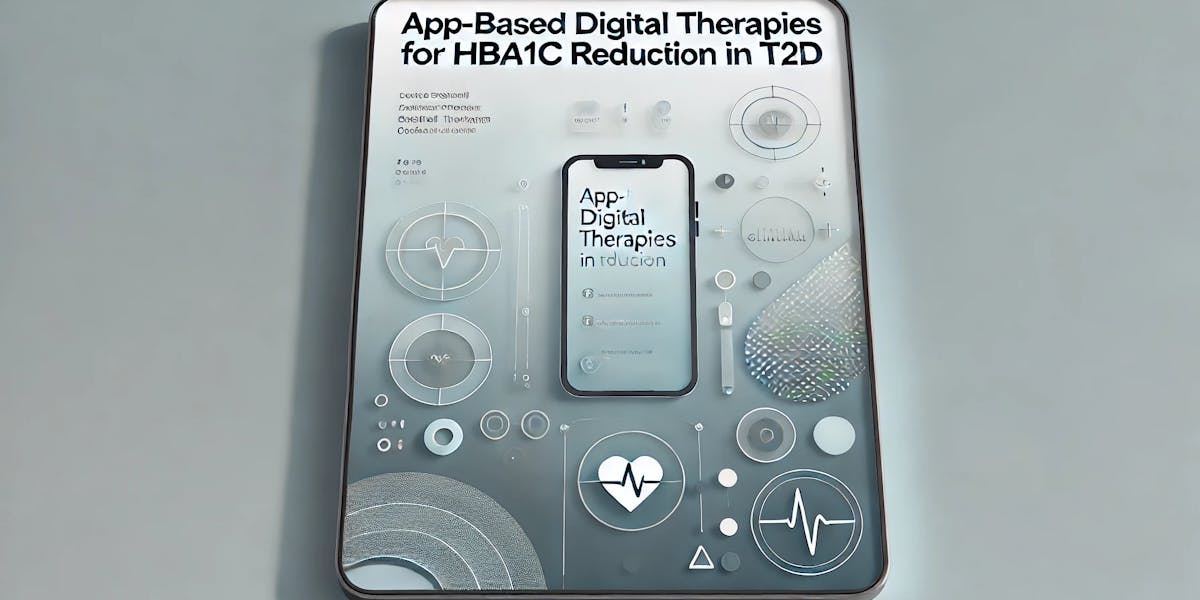App-Based Digital Therapies for HbA1c Reduction in T2D
Journal of Medical Internet Research

Summary
This systematic review and meta-analysis evaluated the effectiveness of multimodal, app-based digital interventions—primarily those that meet Germany’s DiGA criteria—in improving glycemic control among adults with type 2 diabetes mellitus (T2DM). The researchers included 23 eligible studies, comprising both randomized controlled trials (RCTs) and non-randomized designs, and analyzed their impact on hemoglobin A1c (HbA1c) outcomes. Apps incorporated features such as nutritional tracking, physical activity tasks, behavior change techniques, and self-management support. Meta-analytic results showed a statistically significant and clinically meaningful reduction in HbA1c levels of -0.36% compared to control groups and -0.79% within intervention groups overall. While both RCTs and non-RCTs demonstrated effectiveness, quality of evidence varied: RCTs were generally rated as low risk of bias, while non-RCTs often suffered from critical bias due to confounding, data missingness, or unadjusted analyses. Nevertheless, both study types were rated as highly pragmatic (mean PRECIS-2 scores >4), indicating strong external validity. The authors conclude that DiGA-type digital interventions can be a valuable adjunct to standard care for T2DM. Although more robust evidence is needed, especially from long-term studies and with improved transparency in non-RCTs, the integration of such apps into routine care holds promise for widespread adoption.
Study Design
Interventions
Study Type
Outcomes
Duration and Size
Study Population
Age Range
Sex
Geography
Other Criteria
Methodology
The researchers conducted a systematic review and meta-analysis following PRISMA guidelines, with a literature search performed in January 2023 across PubMed, LIVIVO, and Cochrane. Studies were selected using a PICO framework and included app-based lifestyle interventions that aligned with the DiGA definition. The study population was adults with type 2 diabetes and HbA1c ≥6.5%. Inclusion criteria required that interventions be primarily app-based, multimodal, and not pharmacological in nature.
Data extraction and risk-of-bias assessments were conducted independently by two reviewers. Risk of bias was assessed using RoB 2 for RCTs and ROBINS-I for non-RCTs. Additionally, the PRECIS-2 tool was used to assess pragmatism and the GRADE tool was employed to evaluate overall quality of evidence. Statistical analyses involved pooling of between- and within-group HbA1c changes using random-effects meta-analysis models in R. High heterogeneity in non-RCTs was addressed through outlier analysis, and publication bias was evaluated with funnel plots.
Interventions
Interventions were multimodal digital therapies delivered via smartphone apps. These interventions focused on core aspects of diabetes care such as dietary behavior, physical activity promotion, medication adherence, self-monitoring of glucose, and behavioral change support. Many apps also featured coaching elements, automated feedback, and in some cases, communication with healthcare providers. All interventions fit the German DiGA criteria, indicating standalone therapeutic digital devices.
Key Findings
This review found that multimodal, app-based digital health interventions significantly reduced HbA1c levels in adults with type 2 diabetes. The meta-analysis showed a mean reduction of -0.36% compared to control and -0.79% in pre-post analyses. Despite variability in app features and study designs, both RCTs and non-RCTs demonstrated consistent effectiveness, supporting the use of DiGA-compliant digital interventions in clinical practice. While non-RCT evidence was less robust due to methodological weaknesses, its pragmatic nature underscores its value in real-world implementation.
Comparison with other Studies
The results align with previous meta-analyses of telehealth and mHealth interventions in T2DM, which have shown HbA1c reductions in the range of -0.4% to -0.5%. Prior reviews emphasized the role of feedback frequency and healthcare provider involvement; this study, by focusing solely on DiGA-compliant apps, shows that comparable effects can be achieved through primarily patient-led interventions. This supports the feasibility of autonomous digital therapies in glycemic control, without extensive HCP engagement.
Unlike broader telemedicine studies, this review's emphasis on DiGA-defined apps—where the digital tool itself is the therapeutic agent—highlights the regulatory and clinical relevance of such interventions. The study underscores the potential of real-world evidence (RWE) from app usage to complement RCT findings. Despite methodological limitations, the pragmatic value of RWE is increasingly recognized in regulatory settings, particularly for digital therapeutics that evolve rapidly post-market.
Journal Reference
Bodner E, Roth L, Wiencke K, Bischoff C, Schwarz PEH. Effect of multimodal app-based interventions on glycemic control in patients with type 2 diabetes: systematic review and meta-analysis. J Med Internet Res. 2025;27:e54324. doi:10.2196/54324
© 2025 deDiabetes. Licensed under CC BY (Attribution)
Stay informed. Stay ahead.
Subscribe now for the latest breakthroughs, expert insights, and cutting-edge updates in diabetes care—delivered straight to your inbox.